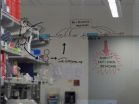(Press-News.org) The hepatitis C virus (HCV) has a previously unrecognized tactic to outwit antiviral responses and sustain a long-term infection. It also turns out that some people are genetically equipped with a strong countermeasure to the virus' attempt to weaken the attack on it.
The details of these findings suggest potential targets for treating HCV, according to a research team led by Dr. Ram Savan, assistant professor of immunology at the University of Washington. The study was published in Nature Immunology.
HCV infects more than 150 million of the world's people. The virus is notorious for evading the body's immune system and establishing an infection that can continue for decades, despite treatment. A lasting infection can damage the liver, and in some cases produce liver cancer. HCV infection is a major cause of liver failure requiring an organ transplant.
The virus, hiding in other tissues, can return in the transplanted liver. HCV and the human immune system are engaged in a seemingly never-ending duel, each trying to overcome the others latest move. Several HCV mechanisms for defying the body's immune system have already been uncovered.
Present treatments are about 70 percent effective in curing the infection, Savan said. The triple combination treatments consist of interferon, ribavirin and direct-acting antiviral agents.
He added, however, that resistant strains of HCV are emerging in antiviral treated patients. Also troubling, he said, is that certain patients can undergo almost a year of treatment weeks – and still be infected. They've endured the unpleasant, flu-like side effects of the regimen with little benefit.
After observing that patients of Asian descent reacted better to HCV treatment than did those of African descent, other research teams searched entire human genomes to identify gene clusters associated with response to therapy.
On chromosome 19, the scientists found different, single-letter DNA code changes linked to treatment response and the natural ability to clear HCV infection.
These tiny genetic variations are located near an area that encodes for interferon-lamda3 (IFNL3), also called interleukin-28B. Viruses can trigger blood cells and other cells to produce this potent substance, which is released to protect against virus invasion.
The mechanism aligning this genetic finding with clearance of HCV had been elusive, Savan's group noted in their paper. His team discovered how the single-letter variation in the IFNL3 gene was responsible for the differences between those who could and those who could not effectively clear HCV.
Individuals who carry the T (for thymidine) variant have an unfavorable outcome in fighting HCV, while those who carry the G (for guanosine) variant have a favorable outcome.
Their data showed that HCV could induce liver cells to target the activities of the IFNL3 gene with two microRNAs. MicroRNAs are silencers: They stop the messengers who transmit information to produce a protein from a gene, in this case the production of the antiviral interferon lambda-3.
These two particular microRNAs are generally turned off in liver cells, until HCV coerces them to act on its behalf. Normally, these so called myomiRs are associated with myosin-encoding genes in skeletal and heart muscle.
"This is a previously unknown strategy by which HCV evades the immune system and suggests that these microRNAs could be therapeutic targets for restoring the host antiviral response," the researchers wrote in their paper. Adding support to this suggestion is the researchers' observation that the bad-acting microRNAs in question could not land on and repress interferon lambda-3, if the host carried the favorable "G" variant.
In those cases, the host is able to escape adverse regulation by HCV, the researchers observed. Savan pointed out that this particular escape variant has been found only in humans, and not in other primates. He said it is not yet known if the G variant arose in humans as a response to selective pressure by infection with HCV.
INFORMATION:
Savan came to the University of Washington in late 2011 from the National Institutes of Health. The first author on the paper, Adelle McFarland, was a research scientist in Savan's lab and is now a graduate student in the Molecular and Cellular Biology Program at the UW.
Funding for this project came from a start-up grant from the UW Department of Immunology and from the National Institutes of Health (HHSN261200800001E, AI060389, AI88778, and CA148068)
Other researchers on the project, reported in the article "The favorable IFNL3 genotype escapes mRNA decay mediated by AU-rich elements and hepatitis C virus-induced microRNAS," were Stacy M. Horner, Abigail Jarret, Rochelle C. Joslyn, all at the UW Department of Immunology at the time of the study; Eckart Bindewald and Mary Carrington of the Frederick National Laboratory for Cancer Research, Bruce A. Shapiro of the National Cancer Institute, and Don A. Delker and Curt H. Hagedorn, both of the University of Utah. Michael Gale, Jr., a collaborator in this study, is from the UW department of Immunology.
A Nature Immunology News & Views commentary, "Outflanking HCV." by Zhigang Tian of the University Of Life Sciences Of China in Hefei, gives a perspective on the research findings.
Newly found tactics in offense-defense struggle with hepatitis C virus
Some people are genetically equipped to resist HCV's efforts to turn off a type interferon
2014-02-10
ELSE PRESS RELEASES FROM THIS DATE:
NTU showcases expertise in UAV technology at Singapore Airshow 2014
2014-02-10
Nanyang Technological University (NTU) will be showcasing its latest R&D expertise in Unmanned Aerial Vehicle (UAV) technology at the Singapore Airshow, one of the most important aerospace and defence exhibitions in the world, held from 11 to 16 February.
Visitors to the Singapore Airshow will be able to see 12 drones, programmed by NTU scientists and researchers, flying in formation within inches of each other and executing complex indoor aerial manoeuvres.
In addition to the formation air-show by 12 quad-rotor Unmanned Aerial Vehicles complete with strobe lights ...
Australians discover oldest star
2014-02-10
A team led by astronomers at The Australian National University has discovered the oldest known star in the Universe, which formed shortly after the Big Bang 13.7 billion years ago.
The discovery has allowed astronomers for the first time to study the chemistry of the first stars, giving scientists a clearer idea of what the Universe was like in its infancy.
"This is the first time that we've been able to unambiguously say that we've found the chemical fingerprint of a first star," said lead researcher, Dr Stefan Keller of the ANU Research School of Astronomy and Astrophysics.
"This ...
New maps reveal locations of species at risk as climate changes
2014-02-10
An international team of scientists has produced global maps showing how fast and in which direction local climates have shifted.
In research published today in the journal Nature, CSIRO and an international team of scientists revealed global maps showing how fast and in which direction local climates are shifting. This new study points to a simpler way of looking at climatic changes and their likely effects on biodiversity.
As climate change unfolds over the next century, plants and animals will need to adapt or shift locations to track their ideal climate.
"The ...
JCI early table of contents for Feb. 10, 2014
2014-02-10
Researchers identify unique regulatory T cell population in human skin
Regulatory T cells (Tregs) dampen the immune response against self antigens and contribute to the prevention of autoimmunity. A skin-specific population of Tregs (mTreg) has been described in mice that has properties similar to memory T cells. In mice, some mTregs are maintained in the skin for long periods of time and suppress cutaneous autoimmunity. In this issue of the Journal of Clinical Investigation, Michael Rosenblum and colleagues at the University of California San Francisco analyzed the mTreg ...
Obesity, type 2 diabetes epidemics spreading to developing world as more own TVs, computer
2014-02-10
Lower income countries may soon be facing the same obesity and diabetes epidemics as their higher income counterparts. Ownership of televisions, cars and computers was recently found to be associated with increased rates of obesity and diabetes in lower and middle income countries, according to an international study published in CMAJ (Canadian Medical Association Journal).
"Although we found no trend between household devices ownership and obesity or diabetes in high income countries, there was a stronger relation as the level of country income decreased. This relation ...
Supreme Court of Canada ruling on life support has wider impact: Hassan Rasouli
2014-02-10
In the debate over whether to withdraw life support for patients who have no hope of recovery, the recent judgment by the Supreme Court of Canada on the Hassan Rasouli case in Ontario has broader implications for health care in the country, argue authors in a commentary in CMAJ (Canadian Medical Association Journal).
The Supreme Court of Canada ruled in October 2013 that physicians who recommend withdrawing life support over the wishes of substitute decision-makers must apply to Ontario's Consent and Capacity Board, "regardless of whether they feel ongoing treatment falls ...
Researchers call for more study into impact of repetitive heading in soccer
2014-02-10
TORONTO, Feb. 10, 2014—Soccer is the most-popular and fastest-growing sport in the world and, like many contact sports, players are at risk of suffering concussions from collisions on the field.
But researchers warned in a paper published today that not enough attention has been given to the unique aspect of soccer – the purposeful use of the head to control the ball – and the long-term consequences of repetitive heading.
The literature review by Dr. Tom Schweizer, director of the Neuroscience Research Program of St. Michael's Hospital, was published in the journal ...
Conserved nuclear envelope protein uses a shuttle service to travel between job sites
2014-02-10
KANSAS CITY, MO—Researchers at the Stowers Institute for Medical Research have glimpsed two proteins working together inside living cells to facilitate communication between the cell's nucleus and its exterior compartment, the cytoplasm. The research provides new clues into how a crucial protein that is found in organisms from yeast to humans does its work.
The study, led by Stowers Investigator Sue Jaspersen, Ph.D., focused on a protein called Ndc1, which controls when and where a cell inserts holes into the double-walled membrane that surrounds its nucleus. In yeast, ...
Weakness exposed in most common cancer gene
2014-02-10
NYU Langone Medical Center researchers have found a biological weakness in the workings of the most commonly mutated gene involved in human cancers, known as mutant K-Ras, which they say can be exploited by drug chemotherapies to thwart tumor growth.
Mutant K-Ras has long been suspected of being the driving force behind more than a third of all cancers, including colon, lung, and a majority of pancreatic cancers. Indeed, Ras cancers, which are unusually aggressive, are thought of as "undruggable" because every previous attempt to stall their growth has failed.
Reporting ...
Transcendental Meditation significantly reduces PTSD in African refugees within 10 days
2014-02-10
African civilians in war-torn countries have experienced the threat of violence or death, and many have witnessed the abuse, torture, rape and even murder of loved ones. Many Congolese living in Ugandan refugee camps are suffering from severe posttraumatic stress disorder (PTSD).
New research shows that Congolese war refugees who learned the Transcendental Meditation® technique showed a significant reduction in posttraumatic stress disorder in just 10 days, according to a study published today in the February 2014 issue of the Journal of Traumatic Stress (Volume 27, ...
LAST 30 PRESS RELEASES:
Interaction of climate change and human activity and its impact on plant diversity in Qinghai-Tibet plateau
From addressing uncertainty to national strategy: an interpretation of Professor Lim Siong Guan’s views
Clinical trials on AI language model use in digestive healthcare
Scientists improve robotic visual–inertial trajectory localization accuracy using cross-modal interaction and selection techniques
Correlation between cancer cachexia and immune-related adverse events in HCC
Human adipose tissue: a new source for functional organoids
Metro lines double as freight highways during off-peak hours, Beijing study shows
Biomedical functions and applications of nanomaterials in tumor diagnosis and treatment: perspectives from ophthalmic oncology
3D imaging unveils how passivation improves perovskite solar cell performance
Enriching framework Al sites in 8-membered rings of Cu-SSZ-39 zeolite to enhance low-temperature ammonia selective catalytic reduction performance
AI-powered RNA drug development: a new frontier in therapeutics
Decoupling the HOR enhancement on PtRu: Dynamically matching interfacial water to reaction coordinates
Sulfur isn’t poisonous when it synergistically acts with phosphine in olefins hydroformylation
URI researchers uncover molecular mechanisms behind speciation in corals
Chitin based carbon aerogel offers a cleaner way to store thermal energy
Tracing hidden sources of nitrate pollution in rapidly changing rural urban landscapes
Viruses on plastic pollution may quietly accelerate the spread of antibiotic resistance
Three UH Rainbow Babies & Children’s faculty elected to prestigious American Pediatric Society
Tunnel resilience models unveiled to aid post-earthquake recovery
Satellite communication systems: the future of 5G/6G connectivity
Space computing power networks: a new frontier for satellite technologies
Experiments advance potential of protein that makes hydrogen sulfide as a therapeutic target for Alzheimer’s disease
Examining private equity’s role in fertility care
Current Molecular Pharmacology achieves a landmark: real-time CiteScore advances to 7.2
Skeletal muscle epigenetic clocks developed using postmortem tissue from an Asian population
Estimating unemployment rates with social media data
Climate policies can backfire by eroding “green” values, study finds
Too much screen time too soon? A*STAR study links infant screen exposure to brain changes and teen anxiety
Global psychiatry mourns Professor Dan Stein, visionary who transformed mental health science across Africa and beyond
KIST develops eco-friendly palladium recovery technology to safeguard resource security
[Press-News.org] Newly found tactics in offense-defense struggle with hepatitis C virusSome people are genetically equipped to resist HCV's efforts to turn off a type interferon





